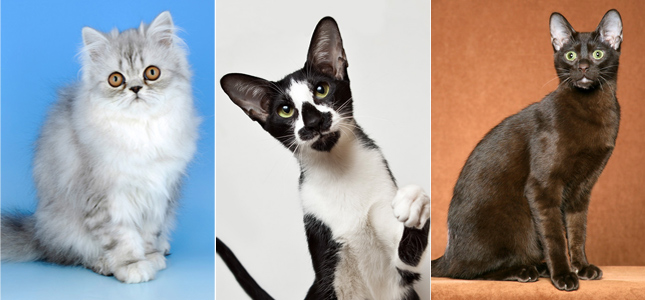Surprising Facts About Pedigreed Cats
Published on January 24, 2014

I think cats are among the most fascinating creatures on earth. In my practice and my travels, I’ve encountered many wonderful cats who have astounded me with their distinctive conformation, coloring and personalities. Among the most memorable are the pedigreed cats, distinguished by their specific body type, coat patterns, hair length and type, and purrsonality.
I love to learn about these fantastic felines, and I hope I can surprise you with these bits of trivia about the supermodels of the cat world.
Cats Around the World
When we think of pedigreed cats, usually only a few come to mind: Siamese, Persian, Abyssinian, Maine Coon. Those are the most popular cat breeds, but around the world, there are more than 70 cat breeds and varieties, each more beautiful and interesting than the last.
The feline faculty for rodent control probably led to the cat’s domestication some 7,000 to 9,000 years ago. According to the latest archaeological and genetic research, cats probably originated in the area known as the Fertile Crescent, the same place where agriculture and civilization were born. Cats likely first became household companions in what are now Egypt, Iran, Lebanon and Turkey, where they were prized for their hunting prowess.
From those early beginnings, cats spread round the world, accompanying merchants as ship’s cats, traveling with traders in caravans and marching with armies. The Phoenicians traded them for tin from Cornwall. Later, travelers brought cats back as souvenirs from exotic lands. I’ve been tempted to do that myself.
Everywhere they went, cats adapted to their new surroundings and began to be bred by people with an eye toward certain qualities. In Japan, people admired certain tricolor cats of red, white and black and associated them with good luck. Although they can come in different colors today, we have come to know this breed as the Japanese Bobtail.
Unusual cats have been prized throughout history, but pedigreed cats became a sensation during the Victorian era. Queen Victoria owned two blue Persians, and the first cat show took place at the Crystal Palace in London in 1871. It was during this time that cat clubs began to be formed, and breeders began to develop the breeds that already existed and create new ones.
Pedigreed Cats Around the World
The Siberian cat and the Norwegian Forest Cat are hardy, longhaired breeds. The Siberian is one of three longhaired breeds that were represented at the very first cat show, held in London in 1871. Norwegian Forest Cats may have inspired the myth that the goddess Freya’s chariot was pulled by two large, longhaired cats.
The Turkish Angora and the Turkish Van are both longhaired cats originating in Turkey, one of the birthplaces of domestic cats. They are both known for an affinity for water and swimming. An old legend claims that the pair of Turkish Vans cruising with Noah jumped off the ark when it reached Mount Ararat in Turkey and swam ashore. When they reached dry land, they headed for Lake Van, from which they take their name.
The American Wirehair was developed from a kitten born with a dominant gene for a wiry coat. American Wirehairs have crimped, hooked or bent hairs that form ringlets and are coarse to the touch, sort of like steel wool. Surprisingly, though, the coat is fragile and needs special care.
Encouraging Genetic Mutations
Many pedigreed cats are the result of a natural mutation that was then molded by people. Some cats such as the Cornish Rex and Devon Rex have genetic mutations that cause them to have curly coats. The curls are the result of a recessive gene.
Other examples of cat breeds that developed from spontaneous natural mutations are the Scottish Fold, whose distinctive ears fold forward, giving him an uncanny resemblance to an owl, and the American Curl, whose ears curve back in a 90- to 180-degree arc.
Often, these “mutant” cats have been bred with other breeds, called outcrossing, to help ensure genetic diversity. For instance, the American Curl and the American Wirehair were outcrossed to domestic shorthairs, and the Cornish Rex was outcrossed to Siamese, Havana Browns, American Shorthairs and domestic shorthairs (non-pedigreed cats). That not only improved their gene pool but also increased the number of colors and patterns found in the breed.
Certain colors and patterns are also the result of genetic mutations. The ticked tabby coloration of the Abyssinian probably developed in the coastal area off the Indian Ocean. High concentrations of cats with this gene are found in Calcutta, India, and the island of Ceylon. Another ticked cat that carries the same gene is the Singapura, from Singapore, noted for being the smallest cat breed. A mutation that occurred somewhere in the Far East created what’s known as the albino series of alleles. It brought us the Siamese, Burmese and Tonkinese breeds.

